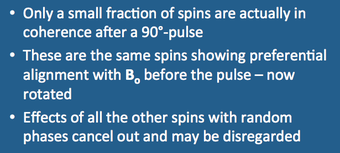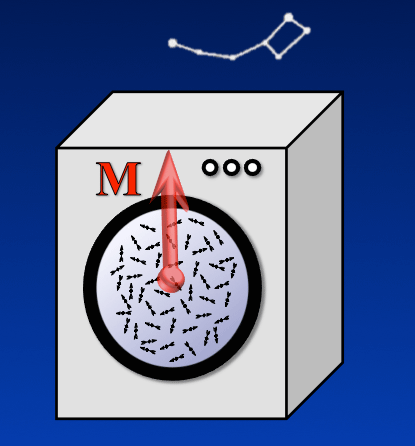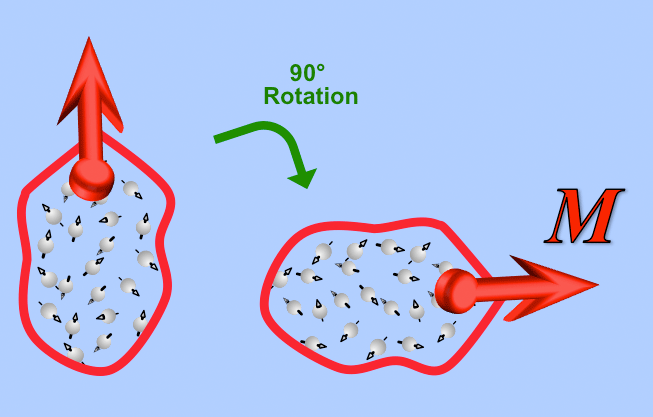It can be shown by relatively straightforward quantum mechanical arguments that a homogeneous RF-field can never change the relative orientations of non-interacting spins. An RF-field can only rotate the spin system as a whole (and thus its net magnetization, M).
|
In this analogy, individual spinning nuclei were likened to tiny compass needles each seeking to point to the north pole (symbolized by the North Star, Polaris). Because of thermal interactions (the dryer rotating), the individual compass needles ended up pointing in all possible directions. On the average, however, more were pointing north than in any other direction. When we summed them all together, we obtained M, the net magnetization (technically, a statistical "expectation") that pointed due North.
At equilibrium prior to the RF-pulse the spin system has a net population difference representing a form of thermodynamic "order". The only effect of the 90°-pulse is to rotate this entire spin-distribution including M into the transverse plane. Thus what was a slightly skewed spin energy distribution in the longitudinal direction has become "phase coherence" in the transverse plane after the RF-pulse. After the 90°-pulse only a small fraction of spins are actually "pointing" in the M direction. The phases of the million+ other spins are all randomly dispersed and cancel each other out, so only the few "coherent" ones contribute to vector M. |
Advanced Discussion (show/hide)»
From a quantum mechanical perspective, recall from a previous Q&A that the wave function describing the hydrogen nucleus could be written as:
Ψ(t) = a |+½> + b |-½>
where a and b are time-dependent quantum amplitudes incorporating "harmonic oscillations" of the two principal states |+½> and |-½>.
When an RF field is applied at the Larmor frequency, its action on the wave function Ψ(t) is to induce a "rotation" or mixing of the a and b components while preserving their total amplitudes (|a|² + |b|²). This is the quantum mechanical explanation for why the transverse magnetization after a 90°-pulse is the same as the longitudinal magnetization before the pulse. It is also the reason that this same amount of magnetization, but no more, can be rotated to 180° or any other angle in an NMR fast passage experiment. In an odd sort of way, therefore, the RF-field really does "rotate" the magnetic moment of a proton, but in a manner much more complex and beautiful than the tipping of a spinning top.
Elster AD. Questions and Answers in MRI, 1st Ed. St. Louis: Mobsy, 1994, pp. 26-28.
Hanson L. Is quantum mechanics necessary for understanding magnetic resonance? Concepts Mag Reson Part A 2008;32A(5):329-340.
What is net magnetization and how does it apply to NMR?
If a system seeks to minimize its total energy level, why don't all the protons simply fall into the lower energy state?


